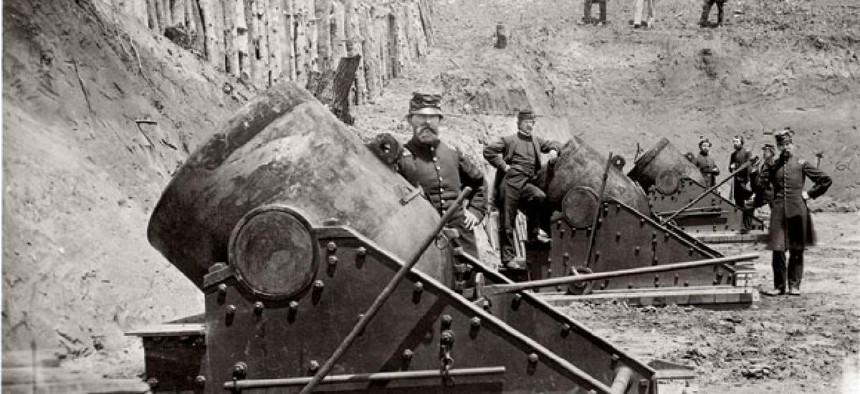
James F. Gibson/Library of Congress/AP
VA's Oldest Beneficiaries
Civil War survivor checks are among mounting veterans payments.
Planners of the U.S.-led invasion of Iraq in 2003 were hardly focusing on the lengthy future of veterans benefit payments their action was locking the government into.
But a decade later, federal checks going to service-disabled veterans and the survivors of those who served in Iraq and Afghanistan have reached $12 billion a year, and that figure is rising. Even more eye-popping, those payments are likely to endure for decades—or even a century.
That judgment stems from the fact that 148 years after the Civil War, the Veterans Affairs Department is still paying $876 a year to two survivors, the Associated Press learned through analysis of payment records obtained under the Freedom of Information Act. The recipients’ names are confidential due to privacy regulations, but they live in North Carolina and Tennessee. The assumption is that these nonagenarian beneficiaries were born to mothers who had married aging veterans of the War Between the States as relatively young women.
Ten survivors of veterans of the 1898 Spanish-American War also continue receiving monthly federal payments, costing about $50,000 a year, says AP. Survivors of World War I (1914-1918), who still number 2,289, collect $20 million annually from VA accounts; those from World War II (1939-1945) receive $5 billion. Veterans of the Korean War (1950-1953) and their survivors still collect $2.8 billion a year.
Moving on to the Vietnam War (1959-1975), AP estimates veterans payments top $22 billion annually.
Reasons for rising payments to Iraq and Afghanistan veterans, experts say, include longevity due to improvements in medical care, as well as a slow economy in which people entitled to benefits are more likely to file claims.
- Charles S. Clark
The Greenest Agency?
Which federal entity is most advanced in environmental sustainability?
Surprisingly, it’s not the Environmental Protection Agency or even the General Services Administration, which promotes green solutions governmentwide.
The question was put to longtime solar energy advocate and consultant Scott Sklar of the Stella Group, who has outfitted his Arlington, Va., home with enough solar panels and energy-efficient materials to power it almost completely off the grid.
The top three agencies for solar and renewable energy, Sklar says, are the Defense Department, the Interior Department and the Federal Aviation Administration.
The Army, “has named six net-zero energy military bases and has a $5 billion process to buy at competitive rates renewable power,” Sklar says. The Navy has a net-zero energy rule and recently completed a zero-energy building at the Washington Navy Yard. And, he says, “the Air Force is the largest buyer of green electricity.”
Interior has issued a streamlined process for renewable energy on federal land and offshore.
The FAA, Sklar says, “has fuel cells and solar panels at airports for powering security and communication systems.”
- Charles S. Clark
Is a picture really worth a thousand words? Or thousands of taxpayer dollars?
That’s the question some federal officials are facing after a Washington Times article revealed the cost of their official portraits—a customary practice among Cabinet members.
During the past two years, taxpayers subsidized nearly $400,000 for paintings of top names including former Environmental Protection Agency Administrator Lisa P. Jackson and Air Force Secretary Michael B. Donley, according to ABC News. Others include former NASA chief Daniel S. Golden, and former Commerce Secretary John Bryson, whose portaits cost more than $20,000 each.
Some lawmakers are pushing back. In April, Rep. Bill Cassidy, R-La., introduced the Eliminating Government-Funded Oil-Painting Act—known as the EGO Act. “As Americans tighten their budgets and cut excess, their government should do the same,” he said on his website.
Not all officials agree, however. Agriculture Secretary Tom Vilsack—whose portait cost $22,500—told ABC News the cost was a “small ball” issue in relation to the $1 trillion federal deficit.
Still, in a town looking to cut waste, critics say it doesn’t paint a pretty picture.
- Kedar Pavgi
Beauty Interrupted
The National Park Service in April limited access to sections of Joshua Tree National Park because of vandalism. Rattlesnake Canyon, a 308-acre section of the park, was closed to the public so staff and volunteers could remove spray-painted graffiti from the defaced rock formations. “While this started as a few markings, social media posts appear to have sparked numerous individuals’ interest in adding to the vandalism of this scenic canyon,” NPS said in a statement.
- Chawndese Hylton
NEXT STORY: It Takes A Village






